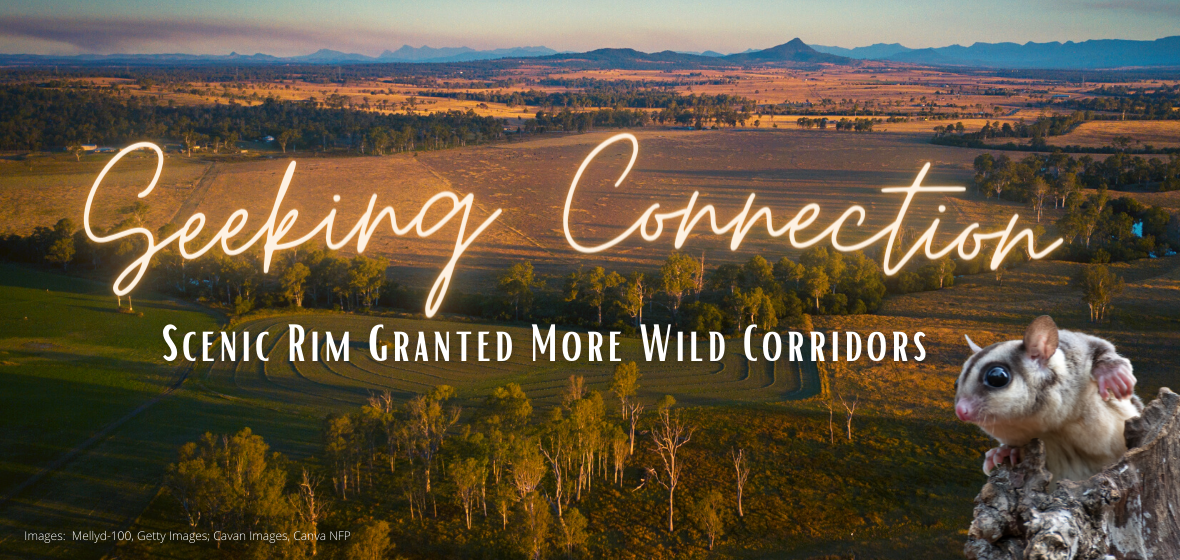
25 August 2021
Wildlife Queensland’s Scenic Rim Branch has received grant funding to continue to expand the region’s vital wildlife corridors and survey the species that use them.
The Federal Government’s Landcare Led Bushfire Recovery Grants Program provides funding to successful organisations located within seven regions most severely affected by the 2019–2020 bushfires, among them the Scenic Rim.
Scenic Rim Branch President Ronda Green says, “Many Australian ecosystems, particularly dry eucalypt forests and heathlands, depend on fire as a natural process for regeneration. But the scale and intensity of bushfires we’ve seen recently, especially in rainforest habitats like the ancient, UNESCO-listed Gondwana Rainforest Reserves, which were considered resistant to bushfire, is worrying. Even more alarming is that these events are set to worsen in a drying climate, so we need to make amends and regenerate these habitats now.”
Linking up what’s left
Habitat fragmentation and loss – whether from catastrophic events such as bushfires, droughts or floods, or resulting from human encroachment on wild spaces – is a persistent threat to Australia’s threatened species.
Modifying natural habitats for agriculture or human housing reduces food and shelter for wildlife, but it also carves up tracts of wilderness. Roads and fences segregate populations, making it risky, and often deadly, for juveniles to disperse from their natal populations to nearby colonies to seek mates or for animals of any age to seek food or water in lean seasons or prolonged droughts.
Many forest or heathland species are innately cautious about leaving dense vegetation. Some will cross open areas if there is something worth crossing for (for example, a koala that remembers a particular stand of trees), but face danger on the ground. It is well known that koalas are often attacked by dogs, but Currumbin Wildlife Hospital receives several a year that have been attacked by cows! Raptors are also always on the lookout for prey.
For threatened species that need sizeable territories (such as the spotted-tailed quoll, koala and greater glider), this restriction of movement also encourages inbreeding and reduces gene flow between populations. Where fragmentation is high and habitat restricted, being cut off can result in dwindling genetic diversity over time. Reduced genetic diversity leaves species vulnerable to disease and to localised extinction events like bushfires.
Pathways to species preservation
To prevent species loss and give wildlife safe passage between Crown land and reserves and patches of suitable habitat on private land, connected corridors of native and revegetated bushland are needed.
Since 2019, Wildlife Queensland’s Scenic Rim Branch ‘Wildlife Corridors Project’ has been planting corridors around the region, most recently at Mt Alford and Wallaces Creek near Boonah. The project focuses on:
- encouraging landowners to protect native trees, shrubs and grasses with guards or wildlife-friendly fencing along corridor routes
- costing and trialling ways to protect saplings and understorey from grazing
- training citizen scientists and volunteers to assist with plantings and surveys
- revegetating ‘gaps’ in existing corridors, either on private land or quiet road verges, and planting species primarily to conserve squirrel gliders but also koalas, grey-crowned babblers, glossy black cockatoos, bandicoots, skinks, native bees and butterflies
- actively searching for and monitoring wildlife within corridors, using observation surveys and motion-sensing cameras
- arranging nest box construction and installation in selected localities that lack mature trees with hollows for arboreal or hollow-dependent species.
All fired-up for the future
These new funds will enable the branch to continue its vital work.
“We’re grateful for the support from Landcare Led Bushfire Recovery Grants funding, which not only validates the work we’ve been doing but also inspires us to increase our efforts in restoring habitats,’ adds Green. ‘Creating more corridors will hopefully reinvigorate populations of species that have been diminished by fire, habitat clearing, droughts and other threatening processes across their range and will provide some insurance for their future.”
Significant updates to the project will begin in September and include:
- increasing corridors between dry sclerophyll forest and wet sclerophyll remnants and rainforest
- planting fleshy-fruited plants in existing corridor routes to sustain rainforest or wet sclerophyll forests species such as Coxen’s fig parrot, fruit doves and grey-headed flying foxes, and shrubby or grassy shelter at rainforest edge for species such as the eastern bristlebird or black-breasted button-quail. Fruiting plants are especially vital for migratory or nomadic species in times of scarcity and when wildlife is escaping storm or fire events.
- undertaking wildlife-safe fencing works to exclude livestock from corridors and encourage landholders who may otherwise find this difficult to afford to appreciate corridors, which also provide windbreaks for crops and shelter for livestock
- raising awareness through community workshops, fauna surveys, and the creation of educational information for landholders
- working with local Landcare groups and property owners to understand and reduce the impact of bushfires on wildlife
- sharing information with council and Healthy Land and Water on plantings and habitat rehabilitation projects on private and council lands
- conducting ‘Wildlife and fire’ information days for landowners to promote the benefits of mosaic burning for wildlife preservation and farm productivity.
The Landcare Led Bushfire Recovery grants program is managed by a partnership between the National Landcare Network, Landcare Australia and the Peak Landcare State and Territory Landcare organisations and is supported by the Australian Government’s Bushfire Recovery Program for Wildlife and their Habitat.
In addition to corridor and planting activities, the grants will enable the purchase of additional motion-sensing cameras to survey species such as brush-tailed rock-wallabies, yellow-bellied gliders, glossy black cockatoos, potoroos, and other species using the corridors.
The Scenic Rim Branch is interested in hearing from any landowners or volunteers eager to assist with tree planting, fencing, surveying and promoting the project. For more details, visit Wildlife Corridors for the Scenic Rim or email the branch.
